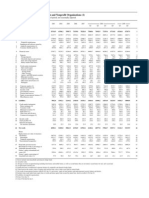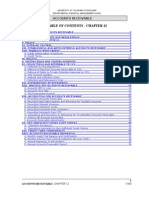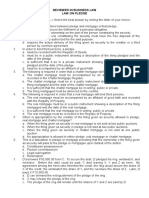LESSON 8 - Purpose of Banks
LESSON 8 - Purpose of Banks
Uploaded by
Chirag HablaniCopyright:
Available Formats
LESSON 8 - Purpose of Banks
LESSON 8 - Purpose of Banks
Uploaded by
Chirag HablaniOriginal Description:
Copyright
Available Formats
Share this document
Did you find this document useful?
Is this content inappropriate?
Copyright:
Available Formats
LESSON 8 - Purpose of Banks
LESSON 8 - Purpose of Banks
Uploaded by
Chirag HablaniCopyright:
Available Formats
LESSON 8 - PURPOSE OF BANKS
Main Lecture:1. Business of Banks What do banks do? We know that most banks serve to accept deposits and make loans. They act as safe stores of wealth for savers and as predictable sources of loans for borrowers. In this way, the major business of banks is that of a financial intermediary between savers and borrowers. The bank simplifies this process by eliminating the need for savers to find the right borrowers and the right time to directly make a loan. Banks are generally trusted by the public. When people put their savings into banks, they receive little more than a paper receipt in return. There are two organizations in place to ensure that banks are trustworthy with individuals' money and reasonable in the loans that they make. Individual banks have a board of directors to regulate the sizes and interest rates of loans the bank makes. This board is charged with ensuring that the bank is taking reasonable risks with its depositors' money. Banks serve another important role. When you look at a check or a debit card you will usually see the name of a bank. Individual banks serve as the issuing and regulating bodies for many financial services often employed by consumers. In this way, banks are able to give depositors access to their money while also maintaining a large number of loans. What happens when you deposit money into a bank? First, the money is recorded (usually by computer) and added to your account. It is then placed into the vault. At various times during the day, money is removed from the vault and taken to a second bank. This bank, unlike the first, does not serve individuals. It is a "banks' bank," usually a branch of the Federal Reserve. The first bank is able to make deposits, withdrawals, and take out loans from the second bank. When you walk into a bank to withdraw money or to take out a loan, the reverse of the process outlined above occurs. If the first bank does not have enough money in the vault to cover the withdrawal or the loan, the first bank goes to the second bank and withdraws money. If the first bank does not have enough money in its account at the second bank, then it must take out a
loan at a lower rate of interest than the loan that it will eventually give to the individual borrower. In this way, a bank is able to accept deposits, honor withdrawals, and make loans without having to maintain all of the deposited cash on hand in the vault. How do banks make money? As financial intermediaries, they earn enough to support their activities by the difference between the interest rate paid to savers and the interest rate charged on loans. When customers make deposits in a savings account, they earn interest on the principle. Similarly, when customers take out loans, they pay interest on the principle. By charging the borrower a slightly higher interest rate than that which is given to the depositor, a bank is able to cover its expenses. 2. Creation of money Banks serve another very important purpose involving the creation of money. To begin, let's go to a simplified world where banks only serve as a safe place to store money. They do not make loans and do not pay interest. Also, let's say that the money supply is only $1000. In this case, if a bank held $100 in deposits, the money supply would simply be $900 since the $100 in the bank would no longer be in circulation. When the depositor withdrew the $100 deposit and spent it, the money supply would again increase to $1000. This system is called a 100% reserve banking system because a bank holds 100% of all of the deposits made. In the real world though, banks are required to hold significantly less than 100% of the deposits in reserve. A bank can make loans, which are then redeposit, and can then be loaned out again; this, in essence, creates money. In this way, any banking system with less than 100% required reserves effectively increases the money supply. This system is called fractional reserve banking because banks hold less than 100% or a fraction of the deposits in reserve. For example, let's say that an economy has a money supply equal to $1000 and that there is a reserve requirement of 50%. If all $1000 is deposited into a bank, half of this amount must be held as reserves to cover withdrawals and half of this amount can be used to make loans. Say the bank gives out $500 in loans. The money is spent and eventually redeposit in the bank. Now, the bank has $1500 deposited. Only $1000 of this amount is in
currency. The other $500 is owed to the bank and exists in a form known as a paper balance. The bank has $1500 in deposits, and since it is required to keep half in reserves, it must keep $750 in currency. This leaves only $250 in currency available for loan seekers. This process continues and real balances are replaced by paper balances until the bank can no longer make loans because all of its currency must be kept in real balances. This action by banks can also be illustrated using a balance sheet procedure. A balance sheet is an accounting tool that lists assets and liabilities. For a bank, reserves and loans serve as assets because they are money that the bank has, or has coming. Deposits, on the other hand, are liabilities; they are money that the bank owes. When creating a balance sheet, the assets are listed on the left and the liabilities are listed on the right.
3. Money Multiplier The process of money creation by banks continues until no more loans can be made due to reserve requirements. Each time a loan is made and redeposit, the possible amount of next loan shrinks. There is an easy way to determine the total money supply created by an initial deposit. Simply
multiply the initial deposit by one over the reserve rate. Then, to find the amount of money created by the bank, simply subtract the initial deposit from this figure. For example, say that $2000 is initially deposited into a bank and the reserve requirement is 20%. What is the change in the money supply created by this deposit? First multiply the initial deposit by one over the reserve rate. This gives $2000 * (1 / .2) = $10,000. Then, subtract the initial deposit: $10,000 $2000 = $8000. Thus, a $2000 deposit yielded an $8000 change in the money supply. Clearly, there are many jobs and purposes for banks. By creating money, banks serve to facilitate many transactions with a relatively small initial money supply. By holding deposits and making loans, banks fulfill the needs of consumers and producers. In this way, banks are more than just financial intermediaries. Banks are in fact crucial to the functioning of the economy. QUESTION ANSWER SESSION: Q.1 What is the major service provided by banks? ANS. The primary role that banks serve is that of financial intermediary. Banks bring together savers and borrowers and make the financial markets work. Q2. What happens when you deposit money in a bank? ANS. First, the money is recorded (usually by computer) and added to your account. It is then placed into the vault. At various times during the day, money is removed from the vault and taken to a second bank. This bank, unlike the first, does not serve individuals. It is a "banks' bank," usually a branch of the Federal Reserve. The first bank is able to make deposits, withdrawals, and take out loans from the second bank. Q3. How do banks earn money? ANS. As financial intermediaries, banks earn enough to support their activities by the difference between the interest rate paid to savers and the
interest rate charged on loans. When customers make deposits in a savings account, they earn interest on the principle. Similarly, when customers take out loans, they pay interest on the principle. By charging the borrower a slightly higher interest rate than that which is given to the depositor, a bank is able to cover its expenses. Finally, banks invest money in low risk stocks and bonds to increase its value.
You might also like
- StatementDocument20 pagesStatementBernadette TsakalosNo ratings yet
- Mini Miranda Warning and Dunning LeterDocument4 pagesMini Miranda Warning and Dunning LeterFreedomofMindNo ratings yet
- PDF 20200812 131130 142277012701921Document4 pagesPDF 20200812 131130 142277012701921Lee LienNo ratings yet
- MPU Courses OUM ACCDocument4 pagesMPU Courses OUM ACCismailNo ratings yet
- Tutorial 030Document8 pagesTutorial 030Jason HenryNo ratings yet
- 2018 Limited Obligation Bond For Tanger Performing Arts Center in GreensboroDocument236 pages2018 Limited Obligation Bond For Tanger Performing Arts Center in GreensborojeffreyhsykesNo ratings yet
- Household Balance Sheet Q2 2009Document6 pagesHousehold Balance Sheet Q2 2009DvNetNo ratings yet
- Pocket Card NoticesDocument4 pagesPocket Card NoticesSnowdenKonan100% (1)
- House Hearing, 112TH Congress - Oversight of The Federal Deposit Insurance Corporation's Structured Transaction ProgramDocument260 pagesHouse Hearing, 112TH Congress - Oversight of The Federal Deposit Insurance Corporation's Structured Transaction ProgramScribd Government DocsNo ratings yet
- Edwin Vieira, Jr. - What Is A Dollar - An Historical Analysis of The Fundamental Question in Monetary Policy PDFDocument33 pagesEdwin Vieira, Jr. - What Is A Dollar - An Historical Analysis of The Fundamental Question in Monetary Policy PDFgkeraunenNo ratings yet
- Tutorial 040Document14 pagesTutorial 040Jason HenryNo ratings yet
- To Regulate The Value of Money by Ed VieiraDocument36 pagesTo Regulate The Value of Money by Ed VieiraHal ShurtleffNo ratings yet
- The Banks Newest Sweetheart DealDocument4 pagesThe Banks Newest Sweetheart Dealmichael s rozeffNo ratings yet
- Table of Contents - Chapter 12: Accounts ReceivableDocument43 pagesTable of Contents - Chapter 12: Accounts Receivabletgbyhn111No ratings yet
- CommerceDocument6 pagesCommerceSakthi100% (1)
- Torts - Outliine Apo ThiafimisiDocument72 pagesTorts - Outliine Apo ThiafimisiAAAABCZZZNo ratings yet
- US Internal Revenue Service: Irb07-39Document72 pagesUS Internal Revenue Service: Irb07-39IRSNo ratings yet
- Form 2220Document15 pagesForm 2220Kam 87No ratings yet
- 21 Banking-Theory-Law and PracticeDocument152 pages21 Banking-Theory-Law and Practiceshree2485No ratings yet
- July 2, 2014 Leave A CommentDocument3 pagesJuly 2, 2014 Leave A CommentMaryann BarberanNo ratings yet
- Bank and Financial Institution Act 2073 2017 PDFDocument101 pagesBank and Financial Institution Act 2073 2017 PDFNisha RaiNo ratings yet
- SB 12-137: Gold and Silver Coin For Payment of DebtsDocument2 pagesSB 12-137: Gold and Silver Coin For Payment of DebtsSenator Mike JohnstonNo ratings yet
- Tutorial 060Document6 pagesTutorial 060Jason HenryNo ratings yet
- TSP WithdrawlsDocument16 pagesTSP Withdrawlsstmccann100% (1)
- 5 Usc Part IiiDocument4 pages5 Usc Part IiiMike SiscoNo ratings yet
- Tutorial 010Document4 pagesTutorial 010Jason HenryNo ratings yet
- Bankruptcy Toll LimitationsDocument6 pagesBankruptcy Toll LimitationsPhantoms001No ratings yet
- Sale of Goods Act 1930Document23 pagesSale of Goods Act 1930Dilfaraz KalawatNo ratings yet
- Nardi Depo Vol 1 - WaMu To JP AssignmentsDocument200 pagesNardi Depo Vol 1 - WaMu To JP AssignmentsJoe EsquivelNo ratings yet
- Tutorial 070Document20 pagesTutorial 070Jason HenryNo ratings yet
- The Big Crash - America Plunges Into Depression: Return of The No-Volume Melt-UpDocument52 pagesThe Big Crash - America Plunges Into Depression: Return of The No-Volume Melt-UpAlbert L. PeiaNo ratings yet
- Sole Prop LetterDocument2 pagesSole Prop LettertamilmaranNo ratings yet
- EscrowDocument1 pageEscrowJason HenryNo ratings yet
- 31 CFR 225.2 - Definitions.Document3 pages31 CFR 225.2 - Definitions.SteveManningNo ratings yet
- TSC Business Plan TemplateDocument25 pagesTSC Business Plan Templateali-faycalNo ratings yet
- Document PDFDocument63 pagesDocument PDFVijay HemwaniNo ratings yet
- Running Head: Estimate The Market Value of Fee Simple Interests 1Document5 pagesRunning Head: Estimate The Market Value of Fee Simple Interests 1Tito MazolaNo ratings yet
- The Nations Credit by CGMDocument22 pagesThe Nations Credit by CGMalexjamesinfoNo ratings yet
- Contracts OutlineDocument25 pagesContracts OutlineErica LindsayNo ratings yet
- Tally Accounting Package Shortcut KeysDocument40 pagesTally Accounting Package Shortcut KeysRaja Vishnudas100% (1)
- USPS OIG Management Advisory - Benchmarking Mail Distribution To CarriersDocument15 pagesUSPS OIG Management Advisory - Benchmarking Mail Distribution To Carriersbsheehan100% (1)
- National Credit Systems Response To Ex-Employee LawsuitDocument48 pagesNational Credit Systems Response To Ex-Employee LawsuitJulie WolfeNo ratings yet
- Banking Law Video Presentation On Escrow and Inchoate Stamped InstrumentsDocument6 pagesBanking Law Video Presentation On Escrow and Inchoate Stamped InstrumentsPraku ShawNo ratings yet
- UCC3 Fro AudreyDocument2 pagesUCC3 Fro AudreyTee MitchellNo ratings yet
- Securitization RevealedDocument5 pagesSecuritization RevealedFrank KaylorNo ratings yet
- Definition Off Balance SheetDocument7 pagesDefinition Off Balance SheetdomomwambiNo ratings yet
- Tutorial 080Document10 pagesTutorial 080Jason HenryNo ratings yet
- Law On PledgeDocument7 pagesLaw On PledgeLesterNo ratings yet
- How To Do A Summary JudgmentDocument10 pagesHow To Do A Summary Judgmentchickie10No ratings yet
- Judgment AssignmentDocument2 pagesJudgment Assignmentolboy92No ratings yet
- Bank of America, NT & SA, Petitioner, vs. COURT OF Appeals, Inter-Resin Industrial Corporation, Francisco Trajano, John Doe and Jane DOE, RespondentsDocument29 pagesBank of America, NT & SA, Petitioner, vs. COURT OF Appeals, Inter-Resin Industrial Corporation, Francisco Trajano, John Doe and Jane DOE, Respondentseasa^belleNo ratings yet
- The Dispatch of MerchantsDocument81 pagesThe Dispatch of MerchantsKristin Cantley SnellNo ratings yet
- JFK Executice Oder 1963Document2 pagesJFK Executice Oder 1963Jason HenryNo ratings yet
- Responsive Documents - CREW: IRS: Regarding Policy On Investigating 501 (C) (3) OrganizationsDocument327 pagesResponsive Documents - CREW: IRS: Regarding Policy On Investigating 501 (C) (3) OrganizationsCREWNo ratings yet
- Mortgaging the Earth: The World Bank, Environmental Impoverishment, and the Crisis of DevelopmentFrom EverandMortgaging the Earth: The World Bank, Environmental Impoverishment, and the Crisis of DevelopmentRating: 4 out of 5 stars4/5 (1)
- Comments on the SEC's Proposed Rules for Regulation CrowdfundingFrom EverandComments on the SEC's Proposed Rules for Regulation CrowdfundingNo ratings yet
- Cnas 22 02 03Document11 pagesCnas 22 02 03sharath00No ratings yet
- Le CorbusierDocument10 pagesLe CorbusierChirag HablaniNo ratings yet
- Evolution of StupasDocument21 pagesEvolution of StupasChirag HablaniNo ratings yet
- Thermal Boredom in ARchitectureDocument2 pagesThermal Boredom in ARchitectureChirag HablaniNo ratings yet
- Liak Teng LitDocument54 pagesLiak Teng LitChirag HablaniNo ratings yet
- Climate Responsive Architecture Creating Greater Design Awareness Among Architects PDFDocument11 pagesClimate Responsive Architecture Creating Greater Design Awareness Among Architects PDFChirag Hablani100% (1)
- Articles: Books: EntrepreneurshipDocument5 pagesArticles: Books: EntrepreneurshipChirag HablaniNo ratings yet
- Articles: BackgroundDocument11 pagesArticles: BackgroundChirag HablaniNo ratings yet
- 978 94 92516 36 7 WebDocument282 pages978 94 92516 36 7 WebChirag HablaniNo ratings yet
- Architecture Books To ReadDocument3 pagesArchitecture Books To ReadChirag HablaniNo ratings yet
- Experiment Voltaic CellsDocument7 pagesExperiment Voltaic CellsChirag HablaniNo ratings yet
- Logarithms Practice Questions: Attempt These Questions Without A CalculatorDocument1 pageLogarithms Practice Questions: Attempt These Questions Without A CalculatorazrindothmanNo ratings yet
- Physics HL (Part 1)Document21 pagesPhysics HL (Part 1)Chirag HablaniNo ratings yet
- Assign Sheet TrigDocument3 pagesAssign Sheet TrigChirag Hablani100% (1)
- Math IaDocument14 pagesMath IaChirag Hablani100% (3)
- Physics HL (Part 2)Document19 pagesPhysics HL (Part 2)Chirag HablaniNo ratings yet
- Financial Awareness Capsule PDF For SBI Clerk Mains 2024Document40 pagesFinancial Awareness Capsule PDF For SBI Clerk Mains 2024ssimu6967No ratings yet
- Invoice #3265573: CV. Rumahweb IndonesiaDocument1 pageInvoice #3265573: CV. Rumahweb Indonesiazeni vaisalNo ratings yet
- Banking Sector in 2007 in The Middle EastDocument21 pagesBanking Sector in 2007 in The Middle EastAbdul_muqtaderNo ratings yet
- Bim JP 2011Q1Document7 pagesBim JP 2011Q1dekicisNo ratings yet
- Transaction Dispute Form 2017Document2 pagesTransaction Dispute Form 2017DesikanNo ratings yet
- Good Luck!: Request For A Copy of The Original Credit Agreement Under The Consumer Credit Act 1974Document23 pagesGood Luck!: Request For A Copy of The Original Credit Agreement Under The Consumer Credit Act 1974jastheoneNo ratings yet
- Gulf Business - April 2011Document92 pagesGulf Business - April 2011motivatepublishingNo ratings yet
- Problem # Sofia James Is A Marketing Entrepreneur Who Has Panache For Selling Anything. SheDocument2 pagesProblem # Sofia James Is A Marketing Entrepreneur Who Has Panache For Selling Anything. SheDebbie DebzNo ratings yet
- Business RegulatoryframeworkDocument28 pagesBusiness Regulatoryframeworknidhi boranaNo ratings yet
- AC414 - Audit and Investigations II - Audit of Cash and Bank BalanceDocument20 pagesAC414 - Audit and Investigations II - Audit of Cash and Bank BalanceTsitsi AbigailNo ratings yet
- PHD Thesis On Banking and FinanceDocument4 pagesPHD Thesis On Banking and FinanceApril Smith100% (1)
- Service Engagement Contract-Joy & Tim 2019Document11 pagesService Engagement Contract-Joy & Tim 2019Adah FeliciaNo ratings yet
- Banking On The Belt and Road Insights From A New Global Dataset of 13427 Chinese Development ProjectsDocument166 pagesBanking On The Belt and Road Insights From A New Global Dataset of 13427 Chinese Development ProjectsJose Luis PerelloNo ratings yet
- AuditDocument30 pagesAuditRosana PlancoNo ratings yet
- Adams Rudolf 2010 08Document32 pagesAdams Rudolf 2010 08Devolina DeshmukhNo ratings yet
- Lumban Senior High School: "The Home of Future Leaders."Document6 pagesLumban Senior High School: "The Home of Future Leaders."Francesnova B. Dela PeñaNo ratings yet
- New Generation Banking in IndiaDocument9 pagesNew Generation Banking in IndiaGanesh TiwariNo ratings yet
- A Study of Grievance Handling Procedure of Banks With Special Reference of Syndicate BankDocument20 pagesA Study of Grievance Handling Procedure of Banks With Special Reference of Syndicate BankChahat MahajanNo ratings yet
- Pdic LawDocument27 pagesPdic LawMarem RiegoNo ratings yet
- AnikDocument3 pagesAnikAnikNo ratings yet
- 33975Document2 pages33975Malik HamidNo ratings yet
- 1 Perfect Capital MobilityDocument3 pages1 Perfect Capital MobilityvxrNo ratings yet
- Role of IT in Banking DepartmentDocument4 pagesRole of IT in Banking DepartmentMubashirAnzaNo ratings yet
- EXIM Bank Body PartDocument28 pagesEXIM Bank Body PartOld PagesNo ratings yet
- Motion To Expunge Lis Pendens DBs FinalDocument22 pagesMotion To Expunge Lis Pendens DBs FinalDwight Bennett100% (2)
- Net Present Value Based Excel Decision Model For MBA CandidatesDocument55 pagesNet Present Value Based Excel Decision Model For MBA CandidatesnabilquadriNo ratings yet
- Seylan Bank Annual Report 2016Document302 pagesSeylan Bank Annual Report 2016yohanmataleNo ratings yet








































































































